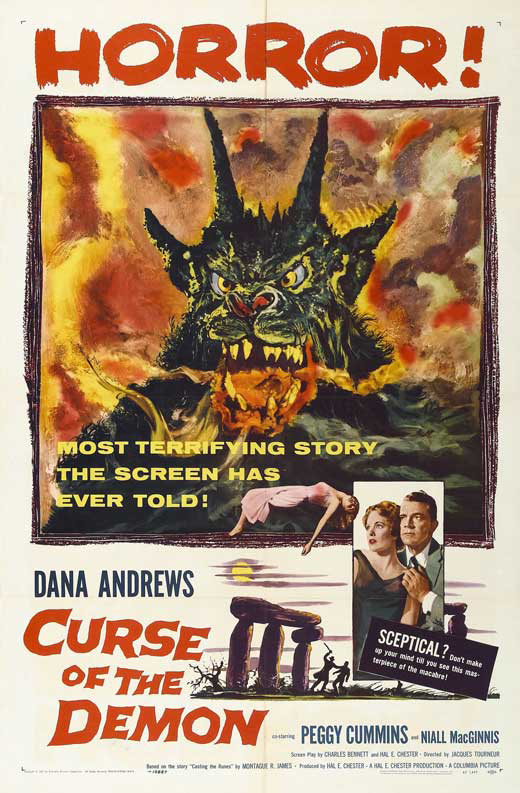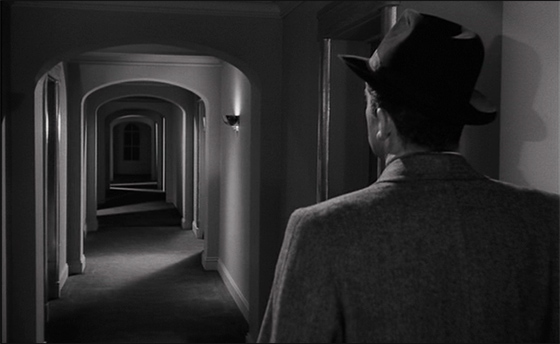
“The paper was narrowly examined. As Harrington had said, the characters on it were more like Runes than anything else, but not decipherable by either man, and both hesitated to copy them, for fear, as they confessed, of perpetuating whatever evil purpose they might conceal… [They were] firmly convinced that it had the effect of bringing its possessors into very undesirable company.” -M.R. James, “Casting the Runes”
Well, they don’t get much better than 1957’s British classic of occult horror, Night of the Demon (released in the U.S., slightly truncated, as Curse of the Demon). Though the end result would leave the director, the great Jacques Tourneur, frustrated that his product had been compromised by producer Hal E. Chester (The Beast from 20,000 Fathoms), over the decades the film’s reputation has risen, and it’s now widely regarded as a triumph of the eerie. Screenwriter Charles Bennett (The 39 Steps) adapted a short story from M.R. James, “Casting the Runes,” first published in the British author’s 1911 collection More Ghost Stories of an Antiquary. To this day, James is better known in his native country than in the United States, despite the fact that his unsettling supernatural tales – often involving scholars whose research and curiosity uncovers vengeful spirits – had a great influence on the writings of H.P. Lovecraft; for a good while the BBC had an annual tradition of adapting one of his ghost stories as a Christmas special. Chester purchased Bennett’s screenplay and polished it; Tourneur was hired to direct; and, as was so common in British B-movies of the day, an American star was imported to help sell the picture in the States: Dana Andrews. The participation of Tourneur and Andrews is key to the film’s uniqueness. Andrews had starred in all kinds of pictures, including William Wyler’s seminal postwar film, The Best Years of Our Lives (1946), but he frequently essayed the hard-boiled, straight-talking tough guy in films like Laura (1944) and Where the Sidewalk Ends (1950). Tourneur had directed three now-classic horror films for Val Lewton (Cat People, I Walked with a Zombie, and The Leopard Man), but also one of the essential film noirs, Out of the Past (1947). Bringing their names to the project guaranteed this would be no ordinary horror picture, but would be rich with noir cynicism, atmosphere, and dread.
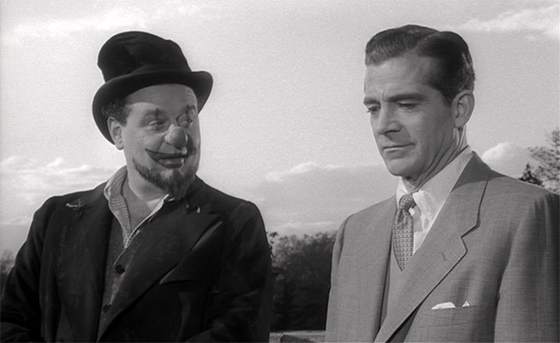
Dr. Holden (Dana Andrews, right) visits Lufford Hall, where the warlock Karswell (Niall MacGinnis) puts on a Halloween magic show for the local kids.
The plot is significantly expanded from the more anecdotal short story, though it is faithful to the premise. Dr. Julian Karswell (Niall MacGinnis, later to play Zeus in Jason and the Argonauts) is a proud practitioner of black magic, whose followers fear him so much that they’ve funded his luxurious and sprawling estate, Lufford Hall. In the original story he’s the author of a treatise about magic who takes supernatural revenge against the publisher who rejected him (something to which any writer can relate); here he’s at war against anyone who would try to prove him a fraud. An opening sequence depicts his enemy, Harrington (Maurice Denham, who provided voices for 1954’s animated Animal Farm), chased out of Lufford by a snarling demon that materializes in a fog from the treetops. His mysterious death leads his niece, the beautiful Joanna Harrington (Peggy Cummins, star of another classic noir, 1950’s Gun Crazy), to get in touch with a psychologist and professional skeptic who seeks to expose and debunk Karswell, Dr. John Holden (Andrews). She soon becomes convinced that Holden will share her uncle’s fate, and believes Karswell’s threat that he will die at “ten o’clock on the 28th of this month,” three days from now. Holden isn’t persuaded of Karswell’s powers, even though the man seems to perform some rather impressive tricks. At a Halloween party on the Lufford grounds, Karswell – wearing clown makeup to entertain children from the local village – seems to summon a spontaneous and violent storm. Later in the film, when Joanna persuades Holden to break into Lufford Hall late at night, a small cat transforms into a leopard and attacks him, then reverts to its original form when Karswell enters the room, switching on the lights. Karswell is all too eager to take ownership of the unearthly happenings that seem to occur. “You said ‘do your worst,'” he casually tells Holden, “and that’s precisely what I did.”
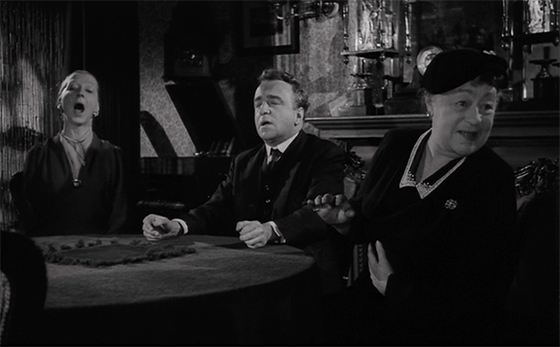
Karswell's mother (Athene Seyler, right) helpfully orchestrates a séance for the benefit of Dr. Holden.
Holden discovers a parchment containing runic writing, which evidently Karswell passed him without his knowing. The paper flies out of his hand and nearly burns in the fireplace, but is caught in the hearth’s screen. All signs seem to indicate that he’s been saddled with a Satanic curse, but he’s unable to decipher the runes on his own (the writing matches that which is etched upon the monoliths at Stonehenge, in an effective use of location shooting). He reluctantly accompanies Joanna to a séance orchestrated by Mrs. Karswell (Athene Seyler), in which a medium named Mr. Meek (Reginald Beckwith) goes into a trance, and his voice transforms as he summons first his spirit guide, then a handful of ghosts before arriving at the late Mr. Harrington. Harrington recounts his own death, and at one point screams, “It’s in the trees – it’s coming!”, dialogue which horror buff Kate Bush would famously sample on her Night of the Demon-inspired 1985 single, “Hounds of Love.” Holden, like Harrington, is ultimately chased by a fog that appears in the trees – and footprints that sink into the ground from the weight of some invisible beast, a la Forbidden Planet‘s Monster from the Id. When Joanna falls victim to Karswell’s mesmerism and taken hostage aboard a train, Holden decides he must set aside his skepticism and slip the cursed runes back to its original owner before the hour of his foretold death – a maneuver that would save his life and destroy the evil Karswell.
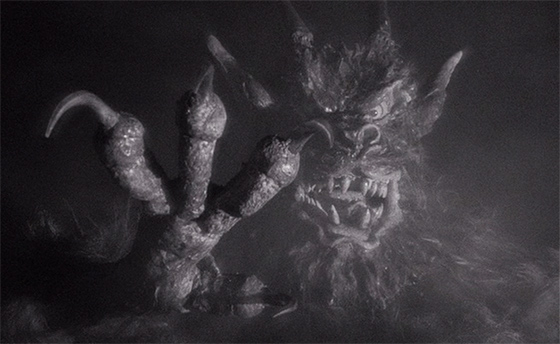
The fire-demon summoned by the ancient runes.
Charles Bennett’s screenplay has some rich dialogue, with most of the great lines going to Dr. Karswell. When he regards the old board game Snakes & Ladders, he remarks wryly to Holden, “I always preferred sliding down the snakes to climbing up the ladders.” MacGinnis’s performance is marvelous, anticipating in many ways Charles Gray’s Mocata in The Devil Rides Out (1968). He is eager to prove his intellectual and magical prowess; and his evident embarrassment at his mother’s accommodating attitude toward his enemies (“I only wanted to show [Joanna] your books; I know how proud you are of them”) adds an element of sublime humor. But it’s the mixture of the occult and noir which makes the film so irresistible. Andrews could be playing his detective from Laura, now out of his depth as he takes on the supernatural. This genre fusion is highlighted by a late-film sequence in which Holden questions a man placed under hypnosis: while the subject speaks of the deadly powers of the runes, the bright glow of the lamp placed between the actor’s face and Holden’s summons the familiar atmosphere of a police interrogation in a crime picture. Tourneur also seems to be importing visual motifs from the land of Val Lewton. He adds some unexpected chills with a simple scene in which Holden gazes both ways down a dark hallway; I was reminded of the Lewton-produced, Mark Robson-directed The Seventh Victim (1943), which also deals with Satanism in a noir setting, and has its own dreadful dark halls. (Some of the spookiness can be credited to production designer Ken Adam, pre-Drs. No and Strangelove.) But Tourneur was unhappy with the finished product, since the show-everything shots of the fire-demon were inserted at the behest of producer Chester. They’re certainly out of character for Tourneur, who practiced, in the Lewton school, the tricks of suggesting more than you show (Cat People being a master course in the subject). It would be simple enough to assemble an edit of the film without the graphic shots of the human-mauling demon…and yet, the close-ups have become so iconic that they now feel sacred, in pop-culture hindsight. Night of the Demon actually earns its monster, because it’s taken such pains to ground the otherworldly in the gritty land of noir, lending credence to Joanna’s suggestion that “You could learn a lot from children. They believe in things in the dark, only we tell them it’s not so. Maybe we’ve been fooling them.”
